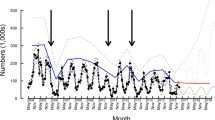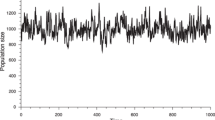Abstract
A long-standing interest in ecology and wildlife management is to find drivers of wildlife population dynamics because it is crucial for implementing the effective wildlife management. Recent studies have demonstrated the usefulness of state-space modeling for this purpose, but we often confront the lack of the necessary time-series data. This is particularly common in wildlife management because of limited funds or early stage of data collection. In this study, we proposed a Bayesian model averaging technique in a state-space modeling framework for identifying the drivers of wildlife population dynamics from limited data. To exemplify the utility of Bayesian model averaging for wildlife management, we illustrate here the population dynamics of wild boars Sus scrofa in Chiba prefecture, central Japan. Despite the fact that our data are limited in both temporal and spatial resolution, Bayesian model averaging revealed the potential influence of bamboo forests and abandoned agricultural fields on wild boar population dynamics, and largely enhanced model predictability compared to the full model. Although Bayesian model averaging is not commonly used in ecology and wildlife management, our case study demonstrated that it may help to find influential drivers of wildlife population dynamics and develop a better management plan even from limited time-series data.


Similar content being viewed by others
References
Acevedo P, Farfan MA, Marquez AL, Delibes-Mateos M, Real R, Vargas JM (2011) Past, present and future of wild ungulates in relation to changes in land use. Landsc Ecol 26:19–31
Asada M (2011) Distribution and pest control, damage to agricultural reduction for wild boar in 2009 in Chiba prefecture, Japan. Rep Chiba Biodivers Cent 3:49–64 (in Japanese)
Barrios-Garcia MN, Ballari SA (2012) Impact of wild boar (Sus scrofa) in its introduced and native range: a review. Biol Invasions 14:2283–2300
Bieber C, Ruf T (2005) Population dynamics in wild boar Sus scrofa: ecology, elasticity of growth rate and implications for the management of pulsed resource consumers. J Appl Ecol 42:1203–1213
Bradley BA, Blumenthal DM, Wilcove DS, Ziska LH (2010) Predicting plant invasions in an era of global change. Trends Ecol Evol 25:310–318
Carlin BP, Chib S (1995) Bayesian model choice via Markov chain Monte Carlo methods. J R Stat Soc B 57:473–484
Chiba Prefectural Government (2011) Wildlife crop damage in 2011 in Chiba prefecture. URL http://www.pref.chiba.lg.jp/noushin/choujuu/yuugai/documents/h23higai.pdf (in Japanese)
Chiba Prefectural Government (2013) Wild boar management program in Chiba prefecture. URL http://www.pref.chiba.lg.jp/noushin/choujuu/yuugai/documents/inosisikeikaku.pdf (in Japanese)
Chiba Prefectural Government, Deer Research Group on Boso (2001) Science report on the management of wild boar and Reeve’s muntjac in Chiba prefecture 1. Chiba prefecture and Deer research group on Boso, Chiba (in Japanese)
Choquenot D (1998) Testing the relative influence of intrinsic and extrinsic variation in food availability on fetal pig populations in Australia’s rangelands. J Anim Ecol 67:887–907
Cote SD, Rooney TP, Tremblay JP, Dussault C, Waller DM (2004) Ecological impacts of deer overabundance. Annu Rev Ecol Evol Syst 35:113–147
Courchamp F, Chapuis JL, Pascal M (2003) Mammal invaders on islands: impact, control and control impact. Biol Rev 78:347–383
Cowled B, Garner G (2008) A review of geospatial and ecological factors affecting disease spread in wild pigs: considerations for models of foot-and-mouth disease spread. Prev Vet Med 87:197–212
Cutini A, Chianucci F, Chirichella R, Donaggio E, Mattioli L, Apollonio M (2013) Mast seeding in deciduous forests of the northern Apennines (Italy) and its influence on wild boar population dynamics. Ann For Sci 70:493–502
Eguchi Y, Tanaka T, Yoshimoto T (2001) Some aspects of farrowing in Japanese wild boar, Sus scrofa Leucomystax, under captive conditions. Anim Sci J 72:J49–J54 (in Japanese)
Estes JA, Terborgh J, Brashares JS, Power ME, Berger J, Bond WJ, Carpenter SR, Essington TE, Holt RD, Jackson JBC, Marquis RJ, Oksanen L, Oksanen T, Paine RT, Pikitch EK, Ripple WJ, Sandin SA, Scheffer M, Schoener TW, Shurin JB, Sinclair ARE, Soule ME, Virtanen R, Wardle DA (2011) Trophic downgrading of planet Earth. Science 333:301–306
Gelman A (2006) Prior distributions for variance parameters in hierarchical models. Bayesian Anal 1:515–533
Gelman A, Carlin JB, Stern HS, Rubin DB (2003) Bayesian data analysis, 2nd edn. Chapman and Hall/CRC Press, Boca Raton
Goodrich JM, Buskirk SW (1995) Control of abundant native vertebrates for conservation of endangered species. Conserv Biol 9:1357–1364
Guisan A, Thuiller W (2005) Predicting species distribution: offering more than simple habitat models. Ecol Lett 8:993–1009
Hamilton G, McVinish R, Mengersen K (2009) Bayesian model averaging for harmful algal bloom prediction. Ecol Appl 19:1805–1814
Hebeisen C, Fattebert J, Baubet E, Fischer C (2008) Estimating wild boar (Sus scrofa) abundance and density using capture-resights in Canton of Geneva, Switzerland. Eur J Wildl Res 54:391–401
Hobbs RJ, Higgs E, Harris JA (2009) Novel ecosystems: implications for conservation and restoration. Trends Ecol Evol 24:599–605
Holland EP, Burrow JF, Dytham C, Aegerter JN (2009) Modelling with uncertainty: introducing a probabilistic framework to predict animal population dynamics. Ecol Model 220:1203–1217
Honda T, Hayashi Y, Sato Y (2008) Habitat selection of wild boar (Sus scrofa) captured near the forest edge. Mamm Sci 48:11–16 (in Japanese)
Iijima H, Nagaike T, Honda T (2013) Estimation of deer population dynamics using a Bayesian state-space model with multiple abundance indices. J Wildl Manag 77:1038–1047
Imperio S, Focardi S, Santini G, Provenzale A (2012) Population dynamics in a guild of four Mediterranean ungulates: density-dependence, environmental effects and inter-specific interactions. Oikos 121:1613–1626
Kitazawa T, Asada M (2010) Wildlife management and ecosystem services on SATOYAMA in Chiba prefecture. Rep Chiba Biodivers Cent 2:85–101 (in Japanese)
Kodani J, Esaki K (2012) Effect of the duration of abandonment on development of understory vegetation in bamboo forest. Jpn J For Environ 54:19–28 (in Japanese)
Kodera Y, Kanzaki N, Kaneko Y, Tokida K (2001) Habitat selection of Japanese wild boar in Iwami district, Shimane prefecture, western Japan. Wildl Conserv Jpn 6:119–129 (in Japanese)
Latimer AM, Wu SS, Gelfand AE, Silander JA (2006) Building statistical models to analyze species distributions. Ecol Appl 16:33–50
Link WA, Barker RJ (2010) Bayesian inference with ecological applications. Academic Press, Amsterdam
Ministry of Agriculture, Forestry and Fisheries (2012) 2010 world census of agriculture and forest in Japan. URL http://www.maff.go.jp/j/tokei/census/afc/2010/houkokusyo.html (in Japanese)
Ministry of the Environment (2009) The 6th and 7th national survey on the natural environment. URL http://www.biodic.go.jp/kiso/fnd_f.html (in Japanese)
Ohashi H, Noba H, Saito M, Tsunoda H, Kuwabara T, Yan M, Kato E, Koike S, Hoshino Y, Toda H, Kaji K (2013) Relationship between plant communities in abandoned field and field sign of wild boar Sus scrofa Linnaeus in southwestern Tochigi prefecture, central Japan. Veg Sci 30:37–49 (in Japanese)
Osawa T, Kohyama K, Mitsuhashi H (2013) Areas of increasing agricultural abandonment overlap the distribution of previously common, currently threatened plant species. PLoS One 8:e79978
Plummer M (2003) JAGS: A program for analysis of Bayesian graphical models using Gibbs sampling. In: Hornik K, Leisch F, Zeileis A (eds), Proceedings of the 3rd international workshop on distributed statistical computing. Vienna University of Technology, Vienna, URL http://www.ci.tuwien.ac.at/Conferences/DSC-2003/Drafts/Plummer.pdf
Podgorski T, Bas G, Jedrzejewska B, Sonnichsen L, Sniezko S, Jedrzejewski W, Okarma H (2013) Spatiotemporal behavioral plasticity of wild boar (Sus scrofa) under contrasting conditions of human pressure: primeval forest and metropolitan area. J Mamm 94:109–119
Pysek P, Richardson DM (2010) Invasive species, environmental change and management, and health. Annu Rev Environ Resour 35:25–55
Royle JA, Dorazio RM (2008) Hierarchical modeling and inference in ecology: the analysis of data from populations, metapopulations and communities. Academic Press, Amsterdam
R core team (2013) R: a language and environment for statistical computing. R Foundation for Statistical Computing, Vienna. URL http://www.R-project.org
Sanderson FJ, Kucharz M, Jobda M, Donald PF (2013) Impacts of agricultural intensification and abandonment on farmland birds in Poland following EU accession. Agric Ecosyst Environ 168:16–24
Schley L, Roper TJ (2003) Diet of wild boar Sus scrofa in Western Europe, with particular reference to consumption of agricultural crops. Mamm Rev 33:43–56
Spiegelhalter DJ, Thomas A, Best NG, Gilks W, Lunn D (1996) BUGS examples version 0.5 Volume 2. MRC Biostatistics Unit, Cambridge
Suzuki S (2008) Expansion of bamboo forest in a bamboo shoot producing area: a case study in Otaki-machi, Chba prefecture, Japan. Veg Sci 25:13–23 (in Japanese)
Thomson JR, Mac Nally R, Fleishman E, Horrocks G (2007) Predicting bird species distributions in reconstructed landscapes. Conserv Biol 21:752–766
Turchin P (2003) Complex population dynamics: a theoretical/empirical synthesis. Princeton University Press, Princeton
Walther GR, Post E, Convey P, Menzel A, Parmesan C, Beebee TJC, Fromentin JM, Hoegh-Guldberg O, Bairlein F (2002) Ecological responses to recent climate change. Nature 416:389–395
Watanabe S (2010) Asymptotic equivalence of Bayes cross validation and widely applicable information criterion in singular learning theory. J Mach Learn Res 11:3571–3594
Wikle CK (2003) Hierarchical Bayesian models for predicting the spread of ecological processes. Ecology 84:1382–1394
Wintle BA, McCarthy MA, Volinsky CT, Kavanagh RP (2003) The use of Bayesian model averaging to better represent uncertainty in ecological models. Conserv Biol 17:1579–1590
Yamanaka S, Ueda E, Fujii Y (2008) Multiple effects of zoning-by-grazing in reducing agricultural damage by wild boars. Bull Shiga Prefect Agric Res Cent Agric Exp Stn 47:51–60 (in Japanese)
Acknowledgments
We are grateful to the public officers of the municipalities in our study area for data collection. We also thank G. Fujita, S. Nishijima, M. Kuroe, and the staff of the Laboratory of Biodiversity Science of the University of Tokyo for helpful comments. This work was supported financially by a Grant-in-Aid for JSPS Fellows (KAKENHI Grant Number 24-7455), The Mitsui & Co., Ltd. Environment Fund (Grant Number R10-C074), and the Japan Society for the Promotion of Science (KAKENHI Grant Number 25281057).
Author information
Authors and Affiliations
Corresponding author
Electronic supplementary material
Below is the link to the electronic supplementary material.
Rights and permissions
About this article
Cite this article
Osada, Y., Kuriyama, T., Asada, M. et al. Exploring the drivers of wildlife population dynamics from insufficient data by Bayesian model averaging. Popul Ecol 57, 485–493 (2015). https://doi.org/10.1007/s10144-015-0498-x
Received:
Accepted:
Published:
Issue Date:
DOI: https://doi.org/10.1007/s10144-015-0498-x




